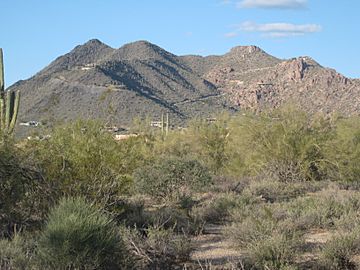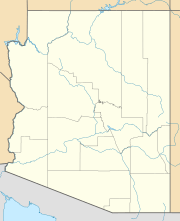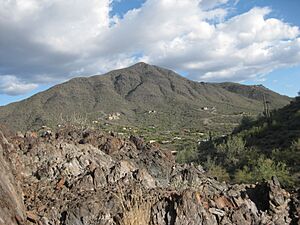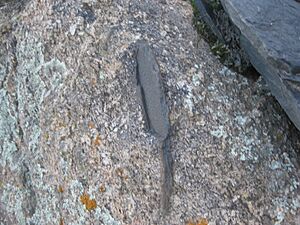Black Mountain (Maricopa County, Arizona) facts for kids
Quick facts for kids Black Mountain, Cave Creek, Arizona |
|
|---|---|

Black Mountain as viewed from the south
|
|
| Highest point | |
| Elevation | 3,403 ft (1,037 m) NAVD 88 |
| Prominence | 1,028 ft (313 m) |
| Geography | |
| Location | Maricopa County, Arizona, U.S. |
| Topo map | USGS Cave Creek, AZ |
Black Mountain is a cool mountain located in north-central Maricopa County, Arizona. You can find it between the towns of Carefree and Cave Creek. It's a well-known landmark in the area, standing tall and offering great views.
Contents
What is Black Mountain Made Of?
Black Mountain is made of two main types of rock. These rocks are split between the western and eastern parts of the mountain.
The Western Side's Dark Rocks
The west side of the mountain is made of a type of rock called "meta-sedimentary rock." This means it was once sedimentary rock, like mudstone, that changed a lot due to heat and pressure. You can see two specific kinds of this rock: phyllite and argillite.
From far away, these rocks might look like basalt, which is a common dark volcanic rock. But Black Mountain actually doesn't have any basalt. The phyllite here has a special layered look. It's like the rock was squeezed and flattened, making it very strong and dark.
The western side of Black Mountain rises almost 1,300 feet above the land around it. The very top of Black Mountain is about 3,398 feet above sea level.
The Eastern Side's Granite Rocks
The eastern side of the mountain is made of granite. This granite formed when hot, melted rock (magma) pushed up into the older meta-sedimentary rock and then cooled down. This large body of granite is called a "batholith." It's about 14 million years old!
This same granite can be found in other famous Arizona mountains. These include the McDowell Mountains, the Union Hills, and even Camelback Mountain. The granite can look different in places. Some parts have large crystals, while others have finer grains.
The granite side of Black Mountain has a flatter top. It's a bit lower than the pointed, dark peak on the western side. The two different rock types meet in a dip or "saddle" between the two peaks.
Where the granite meets the older rock, you can sometimes find pieces of the dark phyllite stuck inside the granite. This shows how the granite pushed its way in. The granite at this meeting point might even look gray because it was discolored by the older rock.
These rocks, both the changed sedimentary rock and the granite, were once hidden deep underground or even under a sea. Over millions of years, erosion has worn away the land above them, revealing them to us today. The dark phyllite rock was once soft mud. It was buried deep, heated, and squeezed. Then, when the granite pushed in, it helped the rocks slide and tilt into their current positions.
Who Lived Around Black Mountain?
The area around Black Mountain has a rich history of different people living there. Today, the towns of Carefree and Cave Creek are home to many people, including artists and business owners. But long ago, Native Americans were the first to live here.
The Ancient Hohokam People
The first known people in this area were the Hohokam. They arrived around 750 A.D. The Hohokam were farmers and also hunted and gathered food. They were very clever and used irrigation to water their crops. You can still see their "waffle gardens" in the Spur Cross Ranch reserve area north of Cave Creek. These were special gardens designed to hold water.
The Hohokam lived in homes called "pit houses." These were partly dug into the ground with rock walls and roofs made of branches and thatch. A good example of a pit house site is the Sears-Kay ruin, northeast of Black Mountain. Sometimes, pit houses are even found when new homes are built in Cave Creek.
Around 1450 A.D., the Hohokam started moving to higher ground. This might have been so they could see enemies like the Yavapai and Tonto Apache tribes coming. Around this time, the Hohokam also stopped burning their dead and started burying them. Some people think this was because there wasn't enough wood for fires, possibly due to a long drought. Others believe a big fire caused them to leave suddenly. Many anthropologists believe the Hohokam eventually moved into the Valley and became the Pima.
The Apache and Early Settlers
From about 1450 until the 1870s, the area was mostly controlled by the Apache, especially the Tonto Apache bands. They were known as raiders. When people tried to start small ranches in the Desert Foothills, the Apache would often attack them.
Things changed in the 1870s when gold was discovered nearby. To protect the miners and other travelers, General George Stoneman and his soldiers built Military Road. This road is now a main street in modern-day Cave Creek. There was also a "remount station" near what is now Spur Cross Road. Here, riders could rest and get a fresh horse before continuing their journey.
Gold Mining and Ranches
After the U.S. Military helped make the area safer, gold mining started to boom. The first gold was found by William Rowe on a place called Gold Hill. The area around Black Mountain was even called the Cave Creek Mining District.
One of the most successful mines was the Phoenix Mine. It was located at what is now the entrance to the Spur Cross Conservancy area. Today, only the leftover piles of rock from the mining are still there. Most mining in the area stopped by 1910.
In the late 1880s, people started cattle and sheep ranches where there was enough water. But droughts and too many animals led to water shortages. So, some ranchers found a new way to make a living: they turned their ranches into "dude ranches." These were places where people from the East could come and experience the "Wild West."
Spur Cross Ranch was a very popular dude ranch near Black Mountain. It stayed open until the 1970s.




